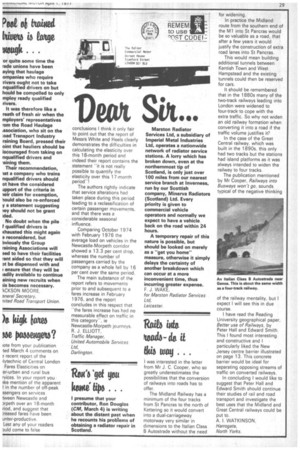Raifa Wit 'teaks do it tido wag.
Page 31

If you've noticed an error in this article please click here to report it so we can fix it.
I was interested in the letter from Mr J. C. Cooper, who so greatly underestimates the possibilities that the conversion of railways into roads has to offer.
The Midland Railway has a minimum of the four tracks from St Pancras to the north of Kettering so it would convert into a dual-carriageway motorway very similar in dimensions to the Italian Class B Autostrade without the need for widening.
In practice the Midland route from the southern end of the M1 into Si Pancras would be so valuable as a road, that after a few years it would justify the construction of extra road lanes into St Pancras.
This would mean building additional tunnels between Kentish Town and West Hampstead and the existing tunnels could then be reserved for cars.
It should be remembered that in the 1880s many of the two-track railways leading into London were widened to four-trackto cope with the extra traffic. So why not widen an old railway formation when converting it into a road if the traffic volume justifies it?
In the case of the Great Central railway, which was built in the 1890s, this only had two tracks but the stations had island platforms as it was always intended to widen the railway to four tracks.
The publication mentioned by Mr Cooper, Railways into Busways won't go, sounds typical of the negative thinking of the railway mentality, but I expect I will see this in due course.
I have read the Reading University geographical paper, Better use of Railways, by Peter Hall and Edward Smith This I found most interesting and constructive and I particularly liked the New Jersey centre barrier illustrated on page 13. This concrete barrier would be ideal for separating opposing streams of traffic on converted railways.
In concluding I would like to suggest that Peter Hall and Edward Smith should continue their studies of rail and road transport and investigate the best uses that the Midland and Great Central railways could be put to.
A. I. WATKINSON, Harrogate, North Yorks.
































































































